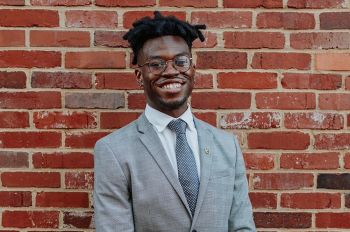The Perfect Fit: Engineering and Architecture Students Collaborate to Develop the Future of Prosthetics

As an expert in digital design and fabrication, Illinois Institute of Technology Studio Associate Professor Alphonso Peluso has long been fixated on how to integrate 3D printing technology into architecture education. The obvious barrier, he says, are the discordant scales of existing 3D printing devices and buildings. Then it hit him: why not use architectural principles and 3D printing to produce something other than a building?
“Applying [3D printing] to prosthetics seemed like a really good place to create alternatives and something beneficial,” says Peluso. “There aren’t a lot of options or alternatives when it comes to prosthetics. But the great thing about 3D printing is that the technology is relatively quick and relatively cheap.”
After putting out the call for the project through Illinois Tech’s RES-MATCH program, which pairs faculty and students with similar research interests in biomedical science or biomedical engineering, Peluso received interest from Jennifer Sabatka (BME 1st Year), a biomedical engineering student who had previously worked on prosthetics as a high school senior. The fit, it would turn out, was perfect.
“I have always been really interested in prosthetics, how they look and how they function, and how they’re put together,” says Sabatka. “I’ve always wanted to explore what we could do with prosthetics and how we could make them better.”
Under the advising of Peluso, Sabatka began working with fellow engineering student Tran Le (BME 4th Year) and two architecture students, Edvin Nielsen Johansson and Ekerin Agboola (B.ARCH. 5th Year), to develop a process for 3D printing a more aesthetically pleasing, lighter, cheaper, and more customizable prosthetic for transtibial amputees, who make up the majority of individuals living with amputations. A transtibial amputation is a below-knee amputation.
While Sabatka focuses on the user needs—such as how to create a more comfortable and ergonomic prosthetic—the architecture students focus on optimizing the prosthetic’s structure. To do so, the team is using generative design software, which optimizes the structural design to use the smallest amount of material possible while achieving the desired strength and durability. This, in turn, would make the prosthetic lighter and cheaper to produce than a standard, handmade unit.
“The tools we have been primarily relying on are Grasshopper for Rhino, a visual programming tool, and Autodesk’s Fusion, a prototyping software. Grasshopper allows us to generate many forms, patterns, and structures, while Fusion helps us optimize the structural patterns toward certain end goals,” says Agboola. “Using these tools in concert allows us a wide range of initial possibilities that we can experiment on when trying to achieve specific performative requirements.”
Likewise, the team is currently experimenting with workflows and materials that would give users a more comfortable fit.
“On average, people with a prosthetic burn twice as many calories as somebody who doesn’t, which is really shocking to hear at first,” says Sabatka. “So, we decided a leg scan would be a part of the process, so you can see how the muscle has healed over the bone and just how general healing has gone to get the general shape. We’re looking at different materials to create a soft, malleable socket customized to the person to reduce pain and reduce stress on the remaining limb that is there.”
Sabatka says that on the surface the biomedical engineering and architecture professions might not make a whole lot of sense together, but in reality, they work well in tandem.
“The way I see it, we’re very similar. We’re trying to find the best design possible and the most efficient way to do it,” says Sabatka. “Having somebody focused on the person and somebody focused on the structure, you can find that beautiful middle ground.”
“Seeing this project as an extension of architecture, or capable of being included in the field of architecture, requires an adjustment of perspective,” adds Agboola. “Seeing this as an architecture problem and being able to respond to this issue as an architect requires me to abandon my own preconceptions about what belongs to architecture and what belongs to prosthetics.”
While the project is still in progress, the group of students plan to produce their final prototype by using an online 3D printing service called Shapeways and present it at the end of the spring 2020 semester.
Photo: Studio Associate Professor Alphonso Peluso [standing] and a group of Illinois Tech students are working to build a more aesthetically pleasing, lighter, cheaper, and more customizable prosthetic.



